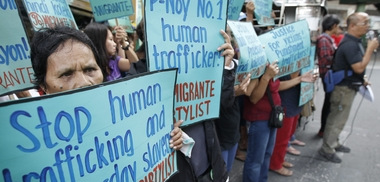(Migrante International, the biggest organization of Filipino groups all over the world, described the state of the Filipino migrants in its Summing Up document released on time for the SONA of Philippine President Aquino and for the global observance of the World Day against Trafficking in Persons last July 30.)
The Philippines remains as one of the top source countries for human trafficking in different parts of the world. Filipinos, mostly women and children, are being trafficked for labor and/or sexual trade to Saudi Arabia, Kuwait, the UAE, Qatar, Bahrain, Malaysia, Hong Kong, Singapore, Japan, South Africa, North America and Europe.
The Aquino government conservatively estimates the number of Filipino victims of trafficking from 300,000 to 400,000, with the number of children victims ranging from 60,000 to 100,000. Many of them migrate to work through legal and illegal means but are later coerced into exploitative conditions, drug trade or white slavery.
The situation has become so alarming that the US government, for non-altruistic reasons, had warned the Philippine government to get its act together lest it remains under Tier 2 of the US Department of State’s Trafficking in Persons Report.
In 2012, the Aquino regime pursued cosmetic reforms, among them signing the Expanded Anti-Trafficking in Persons Act, which upgraded the Philippines to Tier 1, meaning that the country has complied with the minimum standards for the elimination of trafficking.
The amended Anti-Trafficking in Persons Act, otherwise known as Republic Act 10364, defines “trafficking of persons” as the “the recruitment, obtaining, hiring, providing, offering, transportation, transfer, maintaining, harboring, or receipt of persons with or without the victim’s consent or knowledge, within or across national borders by means of threat, or use of force, or other forms of coercion, abduction, fraud, deception, abuse of power or of position, taking advantage of the vulnerability of the person, or, the giving or receiving of payments or benefits to achieve the consent of a person having control over another person for the purpose of exploitation which includes at a minimum, the exploitation or the prostitution of others or other forms of sexual exploitation, forced labor or services, slavery, servitude or the removal or sale of organs.”
This definition of “trafficking in persons” sets a very thin line between human trafficking and illegal recruitment, especially for our OFWs.
Government efforts have hardly scratched the surface of the anti-trafficking campaign, however, much as it lauds itself in media. For one, it only has 17 anti-trafficking prosecutors in the Department of Justice and 72 prosecutors in regional DOJ offices.
And though it has set up the Inter-Agency Council against Trafficking in Persons (IACAT), it has only received and persecuted a handful of human trafficking for investigation since 2010.
Compare this, for example, with an average of 1,500 cases, involving thousands of individuals, yearly that Migrante International receives, majority of which are related to human and sex trafficking, illegal recruitment and drug-related cases.
The ratio of resolution of cases of human trafficking/illegal recruitment in agencies such as the IACAT or POEA are close to nil, with most of perpetrators or recruitment agencies being given mere administrative sanctions and are able to operate again.
Many victims, with the help of Migrante International and other concerned organizations, have filed charges of violations of RA 10364. Unfortunately, the government lacks the political will to fully address the cases.
There are also reports of immigration and police officers who are coddlers of trafficking syndicates but, so far, no public or government official at any level has been prosecuted.
Source:
migranteinternational.org




